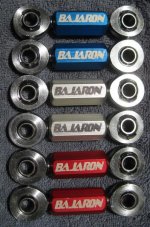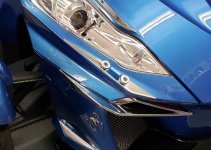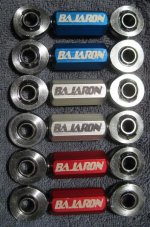I have a question. As opposed to your original link design, which was flat, your new one has the appearance of a turnbuckle. Does it function like one?
The 'Flat' or 'Dog Bone' links work very well for almost everyone. 'Almost' being the key word here. The bearings in those links were corrosion resistant. But for those who rode in high salt content environments, the bearings will eventually rust. I've had to replace a few dozen over the years. And, for those customers. It was only a temporary fix because they will continue to ride in the same environment that destroyed the first set of links.
I would like to have simply upgraded the bearings in those original end links. And, if money were no object, I could have done so. But upgrading to the bearings that I wanted would have added about $24.00 (my cost) to each link set. To me, that was a prohibitive cost increase.
I researched this issue over quite some time. I finally came down to the current product which consists of Chromoly rod ends with hardened, heat treated and hard chromed steel ball bearings, in a self lubricating nylon race. These rod ends have a failure loading of nearly 7,000 lbs. (which is a bit hard to believe). But even if these links do not live up to this lofty number. They will never see anything close to this stress level. And I'm somewhat fond of overkill on critical components anyway.
During my search for a Better Mouse Trap, I purchased several different rod end types and designs. I then soaked them in salt brine for 2 weeks, testing for corrosion and rust. Most of them did OK. But these chromoly rod ends not only look really good. They showed absolutely no signs of any rust or corrosion. The centers of my current End Links are aircraft quality, billet aluminum. Anodizing adds some hardness to the surface of the aluminum. And since the inner threads also get anodized, this increases the load bearing capabilities of the aluminum as well. (And you thought I just wanted to make them look pretty!)
The rod ends thread into each end of the aluminum centers like a turnbuckle. But this is just an assembly aspect. It is important that the rod ends not turn once assembled to the correct overall length and rod end head orientation. So, we use Red Loctite on the threads during assembly. Frankly, all of this requires more labor, and the components are a little more expensive than the previous design. I have been able to get the cost down, somewhat, as we get better at assembly and, now that I am sure we are going to stay with this design, I am able to buy components in larger quantities which gives me some volume discount. But the overall cost to me is still higher than the previous Dog Bone pieces.
I am extremely happy with these new end links. They won't actually function any better than the previous Dog Bone design. But it is my hope that they last the life of the vehicle. We'll see about that. But in any event, my sway bar kits come with a lifetime warranty on parts. I don't want someone riding around on a defective sway bar for want of a part they might not be able to afford right away. Fortunately, even with the old Dog Bone links. Warranty replacement over these 11 years or so has been very low.
Customers have asked if these links are adjustable. The answer is no, the are not. Even if you could adjust them, you would not want to. It is important that these links be the correct length, placing the sway bar arms in a horizontal position. Having the Sway Bar arms horizontal allows the sway bar to be at its most efficient angle. Lengthening or shortening the links would move the sway bar away from this ideal orientation, Lengthening the links would also reduce the number of threads engaged with the billet aluminum center. Potentially weakening the assembly. I wanted as much Rod End to Billet Aluminum Center thread engagement as possible. So, the rod ends are pretty close to being bottomed out, you would not be able to shorten them by much.
Also, it is very important that the rod end heads be perfectly aligned with each other. Allowing customer adjustment could compromise this, raising the possibility of damage and eventual failure of a component.
The only reasons to have adjustable links is to 1- Be able to bring the Sway Bar Arms to a horizontal orientation (say you lowered or raised your car/truck ride height significantly). This has already been done with my link sets. And 2- to bias the action of the Sway Bar assembly. For example; if you are racing on a left hand turn only track. You could adjust the end links and bias the sway bar to be much more aggressive (and come in sooner) on left hand turns only. Of course, in doing this, you would be sacrificing any sway bar action in right hand turns. But who cares? You're only turning right leaving pit row. But you would NEVER want to bias a sway bar in this manner for street use.
In short, yes, my current links appear to be adjustable. But appearances can be deceiving, and you don't want to do it anyway.




